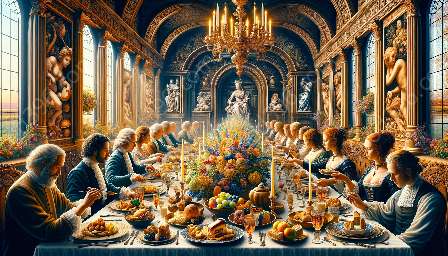Table manners have evolved significantly throughout history, influenced by various factors including food culture, presentation, and dining etiquette. Understanding the evolution of table manners provides insight into the social, cultural, and historical contexts that have shaped our dining experiences.
Evolution of Table Manners
The evolution of table manners can be traced back to ancient civilizations, where communal meals were a central part of society. In ancient Rome, for example, elaborate feasts and banquets were conducted with a strict set of dining etiquette and protocols.
As societies developed, table manners continued to evolve, reflecting changes in social hierarchy, cultural values, and culinary practices. The Middle Ages saw the rise of elaborate dining rituals and the use of elaborate tableware, reflecting the status and wealth of the host.
During the Renaissance, dining etiquette became more refined, with a focus on decorum and sophisticated behaviors at the table. The development of table manners was closely linked to the increasing importance of social status and the role of dining as a display of wealth and power.
Food Presentation and Dining Etiquette
The evolution of table manners was intricately connected to the presentation of food and dining etiquette. The way food was prepared, served, and consumed played a crucial role in shaping table manners and social interactions during meals.
Food presentation evolved from simple communal meals to elaborate banquets and fine dining experiences. The use of intricate tableware, such as silver and porcelain, became a symbol of wealth and sophistication, influencing dining etiquette and behavior at the table.
Dining etiquette encompassed a wide range of norms and customs related to the consumption of food, including the use of cutlery, proper seating arrangements, and polite conversation. As culinary styles and dining practices diversified, so did the customs and manners associated with food consumption.
Food Culture and History
Food culture and history have played a pivotal role in shaping table manners and dining practices. The way food is produced, prepared, and consumed reflects the cultural values, traditions, and beliefs of a society.
Throughout history, various cultures have developed unique food traditions and culinary customs, each influencing the evolution of table manners and dining etiquette. From the elaborate kaiseki meals in Japan to the communal feasts of the Mediterranean, food culture has had a profound impact on the way people interact at the table.
Furthermore, historical events and global interactions have contributed to the exchange of culinary practices and food customs, leading to the evolution of table manners and dining etiquette across different regions and civilizations.
In conclusion, the evolution of table manners is a dynamic and multifaceted process that has been shaped by food culture, presentation, dining etiquette, and history. By understanding the historical and cultural underpinnings of table manners, we gain a deeper appreciation for the social significance of dining and the diverse ways in which people have come together to share meals throughout history.

